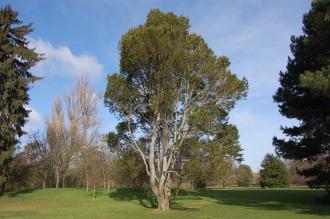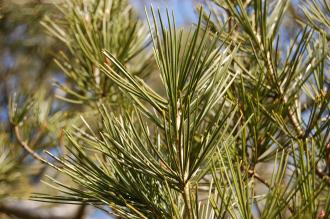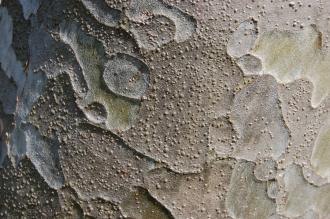
Pinus bungeana (08/02/2015, Kew Gardens, London)
Position: Full sun
Flowering period: Early spring
Soil: Moist, well drained
Eventual Height: 25m
Eventual Spread: 15m
Hardiness: 5a, 5b, 6a, 6b, 7a, 7b, 8a, 8b, 9a
Family: Pinaceae
Pinus bungeana is a slow growing evergreen coniferous tree with a broad pyramidal crown which becomes rounded with age. Its grey/ green leaves are in the form of needles, appear in groups of three, up to 7.5cm long and 2mm across. Its trunk may achieve a diameter of up to 1.1m. Its grey/ green bark is smooth and sheds round plates to reveal pale bark beneath which become red/ purple upon exposure to light. Its male monoecious flowers are in the form of ellipsoid pollen cones. Its fruit are ovoid cones, initially green, maturing to yellow/ brown, up to 7cm long and 6cm across when mature.

Pinus bungeana Leaf (08/02/2015, Kew Gardens, London)
Pinus bungeana, commonly known as Lacebark Pine, Bunge’s Pine or White Barked Pine, is native to north east and central China. In its native habitat this tree it grows in mixed woodland in mountainous regions at an elevation of between 500m and 1800m.
The etymological root of the binomial name Pinus is the old classical name for ‘Pine tree’. Bungeana is named after Aleksandr Andreevic Bunge (1803–1890), a Ukrainian physician and botanist.

Pinus bungeana Bark (08/02/2015, Kew Gardens, London)
The landscape architect may find Pinus bungeana useful as a specimen coniferous tree with attractive bark.
Ecologically, Pinus bungeana the seeds of this tree are attractive to some birds.
Pinus bungeana prefers moist, well-drained soils. It tolerates most pH of soil. It dislikes wet soils
Pinus bungeana requires little maintenance.

